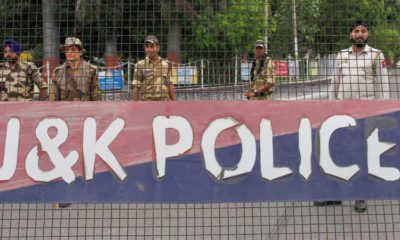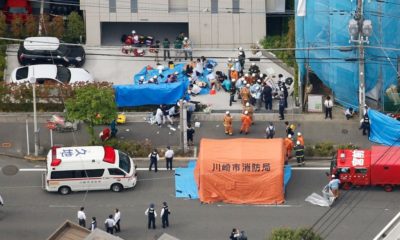Feature
Terrorists involved in Lahore suicide attack killed

Lahore: Ten terrorists of Jamaat-ul-Ahrar and Tehreek-i-Taliban Pakistan (TTP), involved in a suicide attack on Lahore’s Mall Road in February, were killed in a shootout with police in the wee hours today in Lahore.
According to Counter Terrorism Department (CTD) of Punjab police, the terrorists were involved in a suicide attack on Lahore’s Mall Road in February this year in which 15 people including six policemen were killed. Jamat-ul-Ahrar had claimed the responsibility of the attack.
“In early hours today a CTD team were taking the facilitators (Anwarul Haq, Irfan and Imam Shah) of Lahore Mall Road blast suicide bomber to Manawan area to identify the place where they had hidden weapons and ammunition when their accomplices attacked the police team,” a CTD official said.
The police team retaliated and during the cross fire 10 terrorists were killed, he said.
The official said all three facilitators of Lahore Mall Road blast – Anwarul Haq, Irfan and Imam – were killed in the cross fire.
Two of the seven terrorists who attacked the police team have been identified as Attaur Rehman and Abdullah.
The official said all the 10 terrorists belonged to Jamat-ul-Ahrar and TTP. Weapons including hand grenades and explosives have been recovered from the site.
Two senior police officers were among 15 people killed when a Jamat-ul-Ahrar suicide bomber blew himself up during a protest rally outside Pakistan’s Punjab assembly on Feb 13 that also wounded more than 71 others.
Police had arrested main facilitator Anwarul Haq with the help of CCTV and nabbed his other accomplices from tribal area of Bajaur.
Last Wednesday, five soldiers were among seven killed in a suicide attack on an army team taking part in ongoing census in Lahore’s Badian Road. TTP had claimed the responsibility of the attack.
Police have so far taken 15 suspects into custody in connection with Badian Road attack on soldiers.
Police said initial investigation shows that the attacker and his handler were on a motorcycle and continued chasing the census van carrying army personnel.
When the van stopped and the army men started unloading the material, the suicide bomber came closer to them and blew himself up.
“We have arrested 15 suspects in connection with Wednesday’s Lahore blast and are interrogating them,” a senior police officer said.
Entertainment
Meghalaya Reserves Legalized Gambling and Sports Betting for Tourists

The State Scores Extra High on Gaming-Friendly Industry Index
Meghalaya scored 92.85 out of 100 possible points in a Gaming Industry Index and proved to be India’s most gaming-friendly state following its recent profound legislation changes over the field allowing land-based and online gaming, including games of chance, under a licensing regime.
The index by the UK India Business Council (UKIBC) uses a scale of 0 to 100 to measure the level of legalisation on gambling and betting achieved by a state based on the scores over a set of seven different games – lottery, horse racing, betting on sports, poker, rummy, casino and fantasy sports
Starting from February last year, Meghalaya became the third state in India’s northeast to legalise gambling and betting after Sikkim and Nagaland. After consultations with the UKIBC, the state proceeded with the adoption of the Meghalaya Regulation of Gaming Act, 2021 and the nullification of the Meghalaya Prevention of Gambling Act, 1970. Subsequently in December, the Meghalaya Regulation of Gaming Rules, 2021 were notified and came into force.
All for the Tourists
The move to legalise and license various forms of offline and online betting and gambling in Meghalaya is aimed at boosting tourism and creating jobs, and altogether raising taxation revenues for the northeastern state. At the same time, the opportunities to bet and gamble legally will be reserved only for tourists and visitors.
“We came out with a Gaming Act and subsequently framed the Regulation of Gaming Rules, 2021. The government will accordingly issue licenses to operate games of skill and chance, both online and offline,” said James P. K. Sangma, Meghalaya State Law and Taxation Minister speaking in the capital city of Shillong. “But the legalized gambling and gaming will only be for tourists and not residents of Meghalaya,” he continued.
To be allowed to play, tourists and people visiting the state for work or business purposes will have to prove their non-resident status by presenting appropriate documents, in a process similar to a bank KYC (Know Your Customer) procedure.
Meghalaya Reaches Out to a Vast Market
With 140 millions of people in India estimated to bet regularly on sports, and a total of 370 million desi bettors around prominent sporting events, as per data from one of the latest reports by Esse N Videri, Meghalaya is set to reach out and take a piece of a vast market.
Estimates on the financial value of India’s sports betting market, combined across all types of offline channels and online sports and cricket predictions and betting platforms, speak about amounts between $130 and $150 billion (roughly between ₹9.7 and ₹11.5 lakh crore).
Andhra Pradesh, Telangana and Delhi are shown to deliver the highest number of bettors and Meghalaya can count on substantial tourists flow from their betting circles. The sports betting communities of Karnataka, Maharashtra, Uttar Pradesh and Haryana are also not to be underestimated.
Among the sports, cricket is most popular, registering 68 percent of the total bet count analyzed by Esse N Videri. Football takes second position with 11 percent of the bets, followed by betting on FIFA at 7 percent and on eCricket at 5 percent. The last position in the Top 5 of popular sports for betting in India is taken by tennis with 3 percent of the bet count.
Local Citizens will Still have Their Teer Betting
Meghalaya residents will still be permitted to participate in teer betting over arrow-shooting results. Teer is a traditional method of gambling, somewhat similar to a lottery draw, and held under the rules of the Meghalaya Regulation of the Game of Arrow Shooting and the Sale of Teer Tickets Act, 2018.
Teer includes bettors wagering on the number of arrows that reach the target which is placed about 50 meters away from a team of 20 archers positioned in a semicircle.
The archers shoot volleys of arrows at the target for ten minutes, and players place their bets choosing a number between 0 and 99 trying to guess the last two digits of the number of arrows that successfully pierce the target.
If, for example, the number of hits is 256, anyone who has bet on 56 wins an amount eight times bigger than their wager.


























